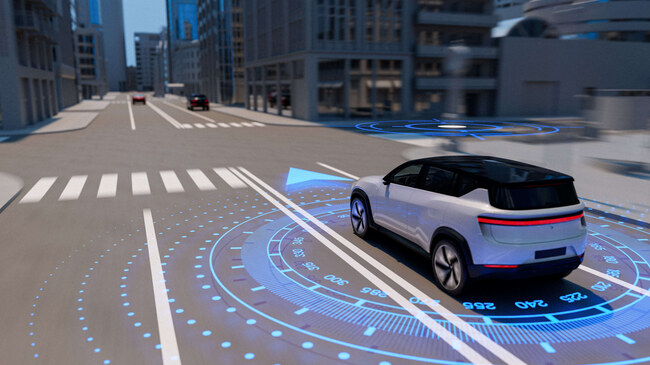Unlocking antenna design flexibility for autonomous vehicles with S-GNSS®
Ramya Sriram
6 min read
28th Nov, 2024
Automotive

In the race towards vehicle autonomy, automakers face a balancing act when it comes to GNSS antennas. On the one hand, these antennas are essential for enabling the accurate positioning and navigation capabilities that self-driving cars depend on. On the other hand, the industry’s demands for sleek aesthetics, cost-efficiency, and performance pose significant challenges.
In this article, FocalPoint’s Product Manager, Jez Ellis-Gray, explains why, as automakers advance their autonomous driving capabilities, boosting antenna performance whilst keeping costs down and maintaining aesthetic design will be a key area of focus.
The Accuracy Imperative for Autonomous Navigation
Accurate GNSS positioning is fundamental for autonomous vehicles to safely navigate their environment. Standard GNSS accuracy typically ranges from 3-5 metres, which may be sufficient for some vehicle features, but falls short of the precision needed for advanced autonomous driving functions.
To achieve higher levels of positioning accuracy, automakers are increasingly turning to correction services like Real-Time Kinematic (RTK) and Precision Point Positioning (PPP) to enable carrier phase tracking. Carrier-phase positioning enables centimeter level positioning, but places a greater demand on the GNSS antenna performance.
The Automotive Antenna Dilemma
GNSS antennas are at the heart of providing accurate positioning data to the vehicles’ systems. However, automotive antenna design involves a delicate balancing act of:
Aesthetics: While the “shark fin” radome has long been a popular solution for integrating GNSS antennas with a low-profile design, the industry is now shifting towards even more discreet alternatives. The latest trend involves fully concealing the antenna within the roof structure or integrating it into the windscreen, allowing for a cleaner, uninterrupted exterior design and vital aerodynamic gains. However, these ultra-compact, hidden solutions compromise performance.
Aesthetics: While the “shark fin” radome has long been a popular solution for integrating GNSS antennas with a low-profile design, the industry is now shifting towards even more discreet alternatives. The latest trend involves fully concealing the antenna within the roof structure or integrating it into the windscreen, allowing for a cleaner, uninterrupted exterior design and vital aerodynamic gains. However, these ultra-compact, hidden solutions compromise performance.
Cost: Automotive OEMs are under pressure to minimise the bill of materials, leading them to opt for lower-cost antenna options that may sacrifice signal quality.
Cost: Automotive OEMs are under pressure to minimise the bill of materials, leading them to opt for lower-cost antenna options that may sacrifice signal quality.
Performance: High-performance antennas with features like multi-element arrays can deliver the enhanced signal reception needed for advanced positioning techniques like RTK and PPP, but they are larger and more expensive.
Performance: High-performance antennas with features like multi-element arrays can deliver the enhanced signal reception needed for advanced positioning techniques like RTK and PPP, but they are larger and more expensive.
Bridging the Gap with S-GNSS® Auto
S-GNSS is a software-based solution that enhances the GNSS measurements, even when using lower-cost, smaller antennas, enabling them to perform on par with or better than more expensive, high-performance alternatives.
By improving the quality of the GNSS measurements, S-GNSS® helps unlock the full potential of GNSS positioning, including advanced techniques like RTK and PPP, even when using constrained antenna designs. This breakthrough allows automakers to:
Adopt smaller, more discreet antenna designs without sacrificing positioning accuracy
Reduce the costs associated with high-end antenna hardware
Maintain the sleek aesthetics demanded by consumers while delivering the performance required for autonomous driving
Adopt smaller, more discreet antenna designs without sacrificing positioning accuracy
Reduce the costs associated with high-end antenna hardware
Maintain the sleek aesthetics demanded by consumers while delivering the performance required for autonomous driving
The Impact on Autonomous Vehicle Design
S-GNSS® effectively breaks the trade-off between antenna size, cost, and performance. This opens up new design possibilities for automakers, empowering them to:
Integrate smaller, more concealed antennas that seamlessly blend into the vehicle’s styling
Leverage cost-effective antenna hardware without compromising positioning capabilities
Deliver the precision needed for advanced autonomous driving features, even when using antennas that would traditionally be considered inadequate
Integrate smaller, more concealed antennas that seamlessly blend into the vehicle’s styling
Leverage cost-effective antenna hardware without compromising positioning capabilities
Deliver the precision needed for advanced autonomous driving features, even when using antennas that would traditionally be considered inadequate
As the automotive industry accelerates towards higher levels of self-driving technology, solutions like S-GNSS® will play a crucial role in unlocking antenna design flexibility and enabling OEMs to meet the competing demands of aesthetics, cost, and performance.
Learn more about our GNSS solution for autonomous vehicles.







